The strengths Russian they have been repeatedly accused of stealing grain from Ukrainian farmers in the occupied areas, as well as other crops such as sunflower seeds, along with fertilizers and farm equipment.
Moscow has repeatedly denied the accusations made from Kyiv*, but this Friday confirmed that it has started to send grain from the occupied territory in Ukraine. A ship carrying 7,000 tons of grain left the Russian-occupied port city of Berdyansk on Friday, a pro-Russian regional official said.
LOOK: Putin’s response to taunts from G7 leaders for his shirtless photos
The BBC spoke to farmers, analyzed satellite imagery and followed monitoring data to look for evidence of Where does the stolen grain go?
A dozen kilometers from the front, Ukrainian farmer Dmytro describes how the business he built for 25 years was lost in four months of Russian occupation.
The BBC tried to contact more than 200 farmers whose land is now in Russian-occupied territory. Dmytro (although we will not use his real name to protect him from retaliation) was one of the few willing to meet us.
“They stole our grain. They destroyed our facilities, they destroyed our machinery.”
He says Russian forces now occupy 80% of the tens of thousands of hectares he farms and accuses them of stealing grain and cereals on an industrial scale.
The surveillance cameras of one of the sites of the company captured the moment the Russians arrived.
We have blurred out some of the surroundings to protect the identities of the farm owners.
Later in the footage, a soldier sees a security camera and shoots at him, but misses.
A lots of trucks used to transport grain were stolen.
But Dmytro says that a couple of them had GPS trackers installed.
we could use this data to check how they had traveled southtowards Crimea, a territory that Russia annexed in 2014, and after that destination they continued towards Russia.
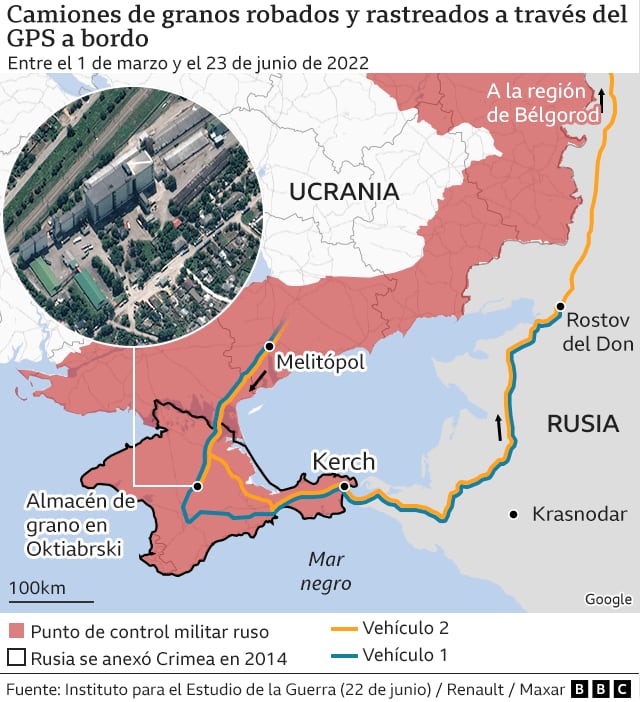
According to GPS data, both trucks stopped near a storage facilityidentified as a site for unloading and storing grain, in the city of Oktiabrski, in Crimea.
In a satellite image from June 14 this year, you can see a row of trucks on the road next to the facility.
We can see that the storage facility It’s next to a railway which can be used to transport grain to Russia or to the ports of southern Crimea.
The top of the storage site also appears to have the Z symbol, the emblem Of The Invasion Of Russia, in the roof.
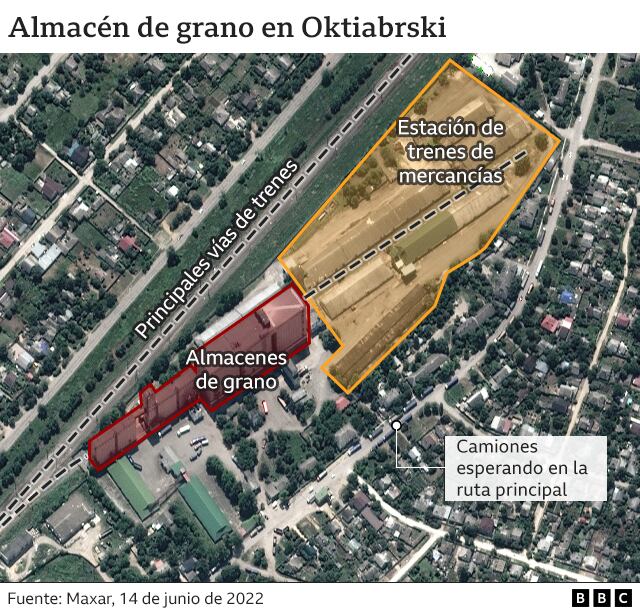
Queues at the border
It is very difficult to trace individual shipments of stolen grain, but there are lots of evidence that much of it goes to Crimea first.
There are satellite images of two key entry points, in the cities of Chonhar and Armiansk, showing a buildup of vehicles, which could be used to transport grain and other goods.
East level of road traffic in Crimea is unusual as Ukraine has not had access to the area since it was annexed by Russia in 2014 and has been exporting grain and other products from elsewhere.
It might be possible to explain some of the traffic volume as empty trucks returning from occupied areas after having delivered supplies to Russian troops.
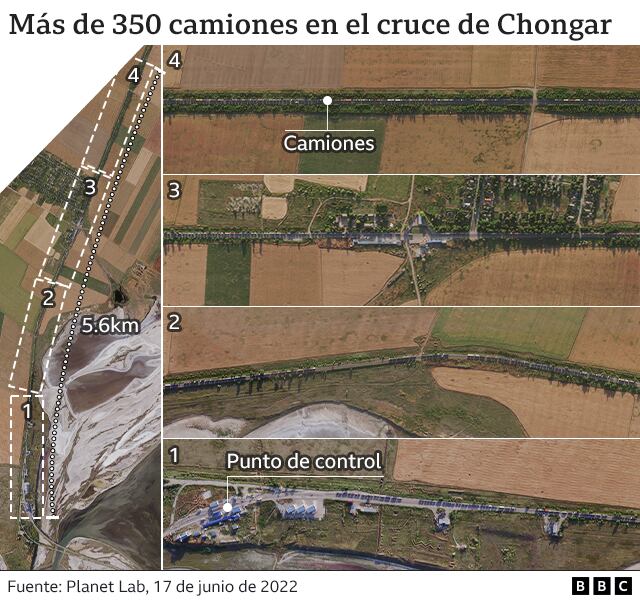
But one obvious interpretation is that many of the trucks are carrying grain or other products such as sunflower seeds, taken from Ukrainian farmers.
trucks waiting
Satellite images of the city of Dzhankoi in Crimea show trucks waiting on a highway next to a grain storage facility that is connected to the train station.
pictures show freight trainswith wagons of the type used to transport grain and other products, at the station next to the storage facility.
Dzhankoi trains are connected with ports of Sevastopol and Kerchwhere products can be moved to Russia or abroad.
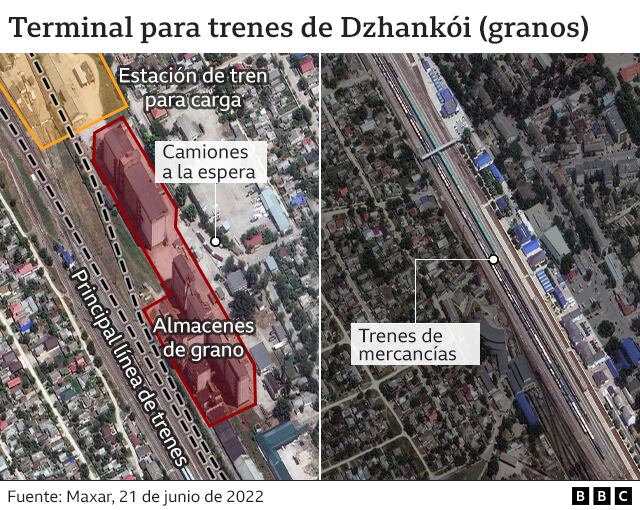
Where does Ukrainian grain go after Crimea?
“First they take the grain to the annexed Crimea, where they transport it to the ports of Kerch or Sevastopol, then they load Ukrainian grain on Russian ships and go to Kerch Strait“, says Andrii Klymenko, an expert at the Institute of Strategic Studies for the Black Sea in Kyiv, who regularly monitors the movements of ships in Crimea.
“There, in the Kerch Strait [entre Crimea y Rusia], transfer Ukrainian grain from small ships to bulk carrierswhere it is mixed with grain from Russia or, in some cases, they sail to this area just to give the appearance of being loaded with Russian grain.”
He adds that all this cereal is exported with Russian certificates that state that the origin is from Russia.
The boats often they have targeted Syria or Turkey.
Turkish Foreign Minister Mevlut Cavusoglu said the country had investigated claims that the grain being shipped was of Ukrainian origin but had so far found no evidence of this.
“We saw in the records that the port of departure of the ships and the origin of the goods is Russia“, said.
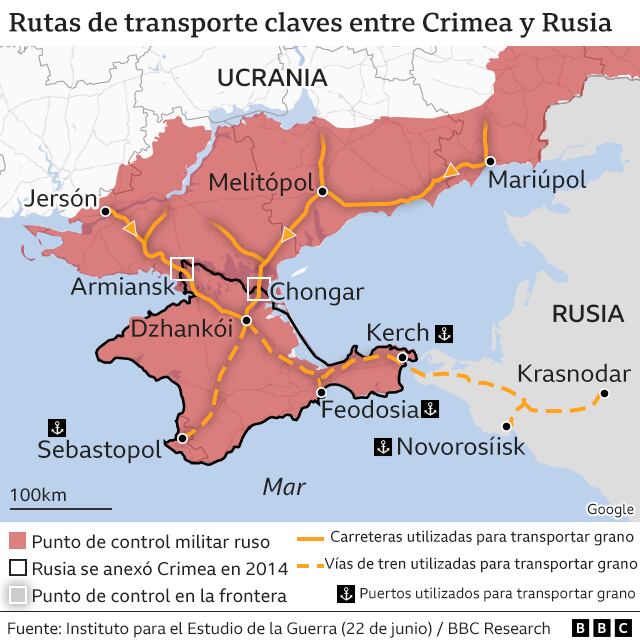
Unusual volume of activity in Sevastopol
Satellite images of the Avlita grain terminal in the port of Sevastopol in western Crimea show a high level of activity throughout June.
It is seen how a yellow commodity, the same color as the grain, is loaded onto a series of ships.
We review the images of the same terminal in June for the past few yearsand the amount of activity seen now appears to be unusually high by comparison.
Some experts we spoke with said that this activity could only be explained by the transport of grain from the Ukrainian mainland.
“In Crimea, not much grain is grown for export,” says Mariia Bogonos, an agricultural policy expert at the Kyiv School of Economics.
It wouldn’t make sense geographically either. that Russia used Sevastopol to export its own grain.
But Mike Lee, an agriculture expert at Green Square Agro who has worked in both Ukraine and Russia, says some grain coming out of Crimea could be part of a accumulation of last year’s harvest, stored due to war.
“Crimea is under Russian control, but supply chains have been affected there as well.”
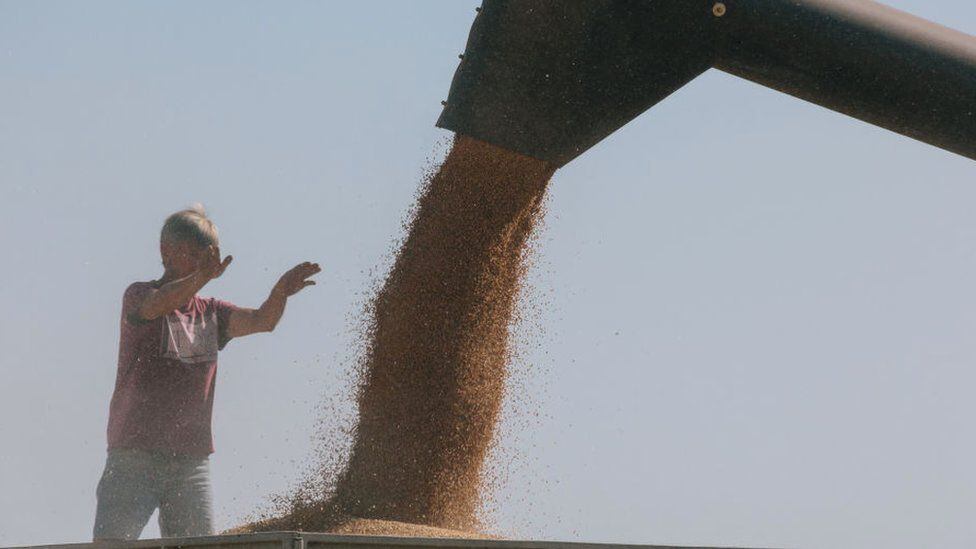
The ships that turn off their trackers
From Crimea, US and Ukrainian authorities and media reports have identified nine ships believed to have carried stolen Ukrainian grain abroad.
Using data from Lloyd’s List Intelligence, the BBC has tracked these ships on voyages between Crimea and ports in Turkey and Syria since April.
Lloyd’s List Intelligence says the ships have used what maritime specialists would describe as “deceptive” browsing practices: turn off their shipboard trackers when entering the Black Sea or moving around the Kerch Strait near Crimea.
When their trackers come back online, the ships sail south with many reporting a shallower depth in the water, which suggests that they loaded goods during the time they were without GPS.
The BBC mapped the voyages of three ships: the Matros Pozynitch and the Sormovskiy 48owned by two companies in Russia, as well as the finikia, owned by the Syrian General Maritime Authority.
We tried to contact the Russian-registered owners of these ships to inquire about the voyages, but received no response.
We were unable to communicate with the Syrian owners.
Despite the gaps in your tracking historiessatellite images have revealed where some of the ships have been.
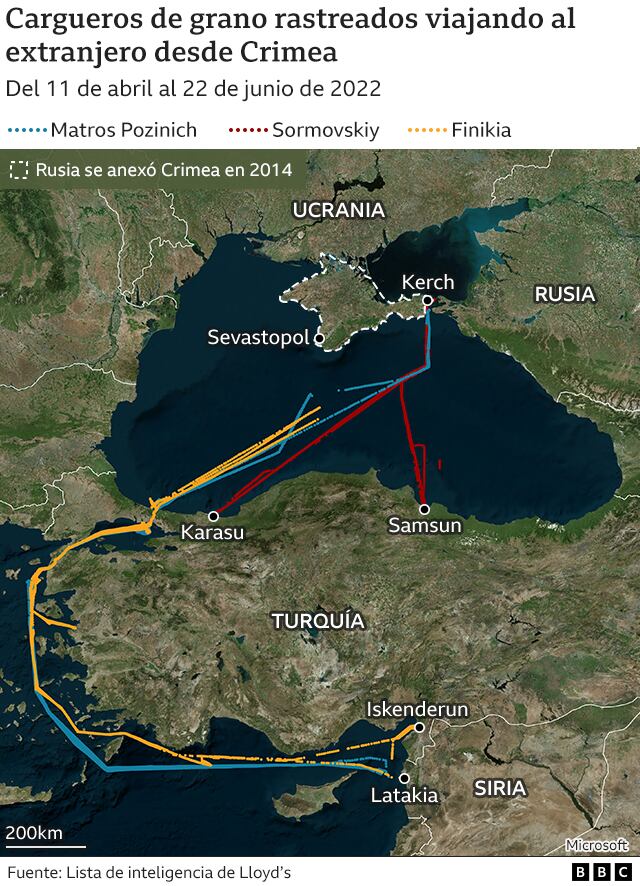
Maxar footage shows the Matros Pozynich ship in Sevastopol, Crimea, in mid-May.
During this voyage, he sailed to the Kerch Strait, kept his transponder off for five days and then reappeared hundreds of miles to the south in the Black Sea.
later it was photographed in the Syrian port of Latakia.
But again I had deactivated tracking system.
Under the UN’s Safety of Life at Sea (SOLAS) law, ships must have their trackers turned on at all times, unless it poses a threat to their safety, for example from piracy.
Michelle Wiese Bockmann, market editor at Lloyd’s, believes that there is no justification for turning off the trackers near Crimea or near the Syrian coast.
“This practice is clearly not related to the risks of piracy”Bockman says.
“Other ships have their transponders on, so why not them?”
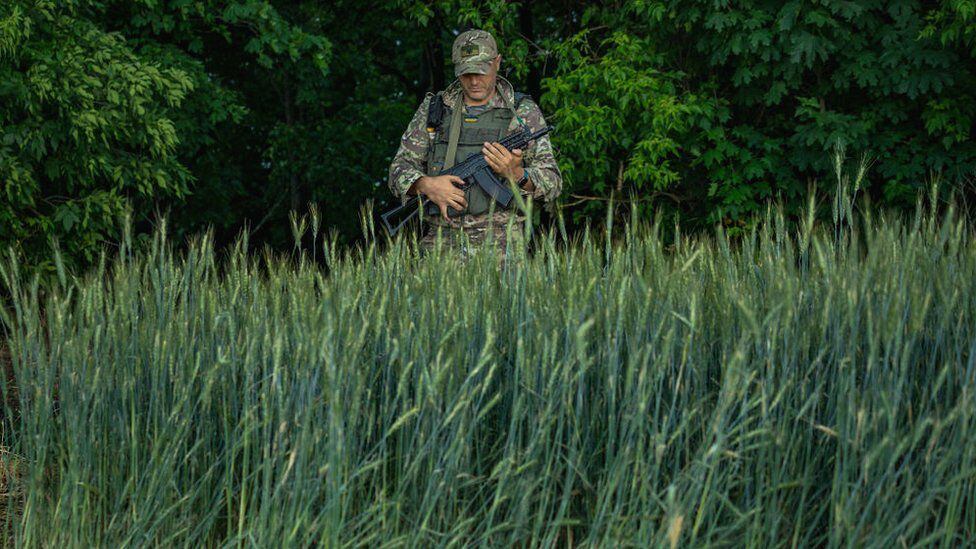
Russian tactics
The BBC also obtained documents produced by the Russian occupation authorities that they list the farms where the grain will be transferred to them.
A separate investigation by the BBC’s Russian and Ukrainian services has shown that, in some cases, the russians are forcing ukrainian farmers to sell grain at prices well below market rates and sign documents to prove they were “legally” purchased.
Although the first reports were generally of direct thefts by Russian forces, the farmers suggest that there have been a change in tactics as that the Russians realize that if they pay nothing, future harvests could be sabotaged.
Farmers say that they have to accept low prices since they have no alternative and need to buy fuel and pay the workers.
Emilie Pottle, an international law lawyer, told the BBC that these actions may violate the rules of the Geneva Convention and the International Criminal Court (CPI) that govern the occupying powers.
We have also contacted the Russian authorities to inquire about these allegations, but have not yet received a response.
*BBC Mundo has decided to adopt Kyiv when naming the capital of Ukraine to more accurately reflect its original spelling in Ukrainian.
Source: Elcomercio
I, Ronald Payne, am a journalist and author who dedicated his life to telling the stories that need to be said. I have over 7 years of experience as a reporter and editor, covering everything from politics to business to crime.

:quality(75)/cloudfront-us-east-1.images.arcpublishing.com/elcomercio/GE3TANRNGA3S2MBTKQYDAORRG4.png)

:quality(75)/cloudfront-us-east-1.images.arcpublishing.com/elcomercio/Y6HCBDCE4NCTDKFIE7PEJI6TDA.jpg)
:quality(75)/cloudfront-us-east-1.images.arcpublishing.com/elcomercio/CAZVRR46TJAQJDQYEHP5VH5WMY.jpg)
:quality(75)/cloudfront-us-east-1.images.arcpublishing.com/elcomercio/Z5DOMID4JZG5VID3KK45B666RA.png)
:quality(75)/cloudfront-us-east-1.images.arcpublishing.com/elcomercio/PXLPMWMWCZCC5CQZIB44IPE64Q.jpg)
